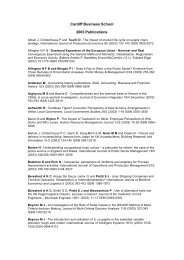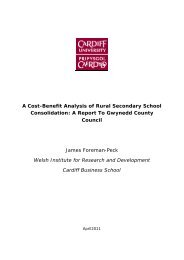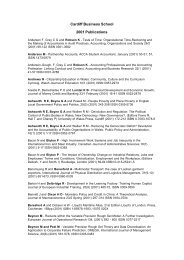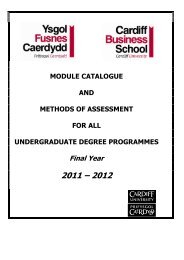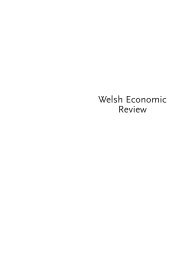Revisiting the Great Moderation using the Method of Indirect Inference
Revisiting the Great Moderation using the Method of Indirect Inference
Revisiting the Great Moderation using the Method of Indirect Inference
You also want an ePaper? Increase the reach of your titles
YUMPU automatically turns print PDFs into web optimized ePapers that Google loves.
c) nei<strong>the</strong>r model is rejected but <strong>the</strong> Wald statistic <strong>of</strong> one is lower than <strong>the</strong> o<strong>the</strong>r's.<br />
In cases b) and c) we can convert <strong>the</strong> Wald into a p-value, which can loosely be<br />
described as <strong>the</strong> probability <strong>of</strong> <strong>the</strong> model being true given <strong>the</strong> data. The models can be<br />
ranked by <strong>the</strong>se p-values in terms <strong>of</strong> <strong>the</strong>ir probability or `closeness' to <strong>the</strong> data behaviour.<br />
In case b) this ranking is merely information about possible misspecications. In case c)<br />
one can regard <strong>the</strong> model with <strong>the</strong> lower p-value as an approximation to <strong>the</strong> `true' model<br />
with <strong>the</strong> higher p-value; thus both are `true' in this method (i.e. not rejected), but one<br />
is a poorer approximation to <strong>the</strong> true causal structure.<br />
6 Data and Results<br />
We evaluate <strong>the</strong> models against <strong>the</strong> US experience since <strong>the</strong> breakdown <strong>of</strong> <strong>the</strong> Bretton<br />
Woods system <strong>using</strong> quarterly data published by <strong>the</strong> Federal Reserve Bank <strong>of</strong> St. Louis<br />
from 1972 to 2007 13 . This covers both <strong>the</strong> <strong>Great</strong> Acceleration and <strong>the</strong> <strong>Great</strong> <strong>Moderation</strong><br />
episodes <strong>of</strong> <strong>the</strong> US history.<br />
The time series involved for <strong>the</strong> given baseline model include ~{ t , measured as <strong>the</strong><br />
deviation <strong>of</strong> <strong>the</strong> current Fed rates from its steady-state value, <strong>the</strong> output gap x t , approximated<br />
by <strong>the</strong> percentage deviation <strong>of</strong> real GDP from its HP trend, and <strong>the</strong> quarterly<br />
rate <strong>of</strong> ination t , dened as <strong>the</strong> quarterly log dierence <strong>of</strong> <strong>the</strong> CPI 14 .<br />
13 http://research.stlouisfed.org/fred2/.<br />
14 Note by dening <strong>the</strong> output gap as <strong>the</strong> HP-ltered log output we have eectively assumed that <strong>the</strong><br />
HP trend approximates <strong>the</strong> exible-price output in line with <strong>the</strong> bulk <strong>of</strong> o<strong>the</strong>r empirical work. To estimate<br />
<strong>the</strong> exible-price output from <strong>the</strong> full DSGE model that underlies our three-equation representation, we<br />
would need to specify that model in detail, estimate <strong>the</strong> structural shocks within it and t <strong>the</strong> model to<br />
<strong>the</strong> unltered data, in order to estimate <strong>the</strong> output that would have resulted from <strong>the</strong>se shocks under<br />
exible prices. This is a substantial undertaking well beyond <strong>the</strong> scope <strong>of</strong> this paper, though something<br />
worth pursuing in future work.<br />
Le et al. (2011) test <strong>the</strong> Smets and Wouters (2007) US model by <strong>the</strong> same methods as we use here.<br />
This has a Taylor Rule that responds to exible-price output. It is also close to <strong>the</strong> timeless optimum<br />
since, besides ination, it responds mainly not to <strong>the</strong> level <strong>of</strong> <strong>the</strong> output gap but to its rate <strong>of</strong> change<br />
and also has strong persistence so that <strong>the</strong>se responses cumulate strongly. Le et al. nd that <strong>the</strong> best<br />
empirical representation <strong>of</strong> <strong>the</strong> output gap treats <strong>the</strong> output trend as a linear or HP trend instead <strong>of</strong><br />
<strong>the</strong> exible-price output|this Taylor Rule is used in <strong>the</strong> best-tting `weighted' models for both <strong>the</strong> full<br />
sample and <strong>the</strong> sample from 1984. Thus while in principle <strong>the</strong> output trend should be <strong>the</strong> exible-price<br />
output solution, it may be that in practice <strong>the</strong>se models capture this ra<strong>the</strong>r badly so that it performs<br />
less well than <strong>the</strong> linear or HP trends.<br />
We have also purposely adjusted <strong>the</strong> annual Fed rates from <strong>the</strong> Fred R to quarterly rates so <strong>the</strong><br />
19



